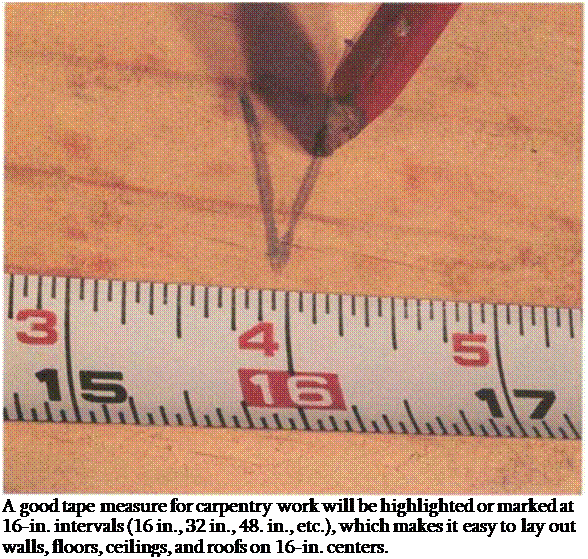TAPE MEASURES
Taking measurements has radically changed since I started building. My everyday measuring tool used to be a 6-ft. folding ruler. Imagine the time it took to measure and cut a board to length, especially one over 6 ft. long.
First I had to unfold the ruler, section by section, then measure out the distance on the board. Then I had to fold up the ruler and put it away. It’s no wonder that steel tape measures are now much more common on job sites everywhere.
Tape measures get used a lot and so require special care. Here are some maintenance tips to ensure that your tapes continue to work smoothly for a long time.
• Don’t leave an extended tape lying around on the floor. If someone steps on the tape, it will be creased and will never work properly again.
• Don’t let a tape reel in too fast.
If the hook on the end hits the case at full speed, the hook can break off. Slow the tape down with your fingers.
• Keep the tape clean, or it will be difficult to pull out and reel in. Tapes gummed with wood pitch, tar, or caulk can be cleaned with a soft rag and some mineral spirits (paint thinner).
• When working in wet conditions, wipe the tape dry with a cloth before reeling it back into the case.

A tape measure has a hook on the end of a flexible steel blade that grabs the edge of a workpiece. The blade can be locked in place so that measuring becomes a one-person job.
Many sizes are available, but the two most commonly found on a job site are 16 ft. and 25 ft. Longer tape measures (up to 100 ft. or more) made of steel or cloth are also available. They work well to lay out long distances like the foundation of a new house or when measuring the exact location of a building when siting it on a lot.
Most tape measures used for general construction have an extra mark at 1 б-in. intervals (see the photo at left). Because this spacing is often standard for studs in a wall, joists in a ceiling, or rafters in a roof, these marks are helpful when laying out a house frame. Some tapes have decimal equivalents and metric conversion charts on the back.
To snap a chalkline for a short distance, hold one end of the line with one hand and the other end with the little finger of the second hand. Pick up the taut line with the thumb and forefinger of your second hand and snap it.






Leave a reply